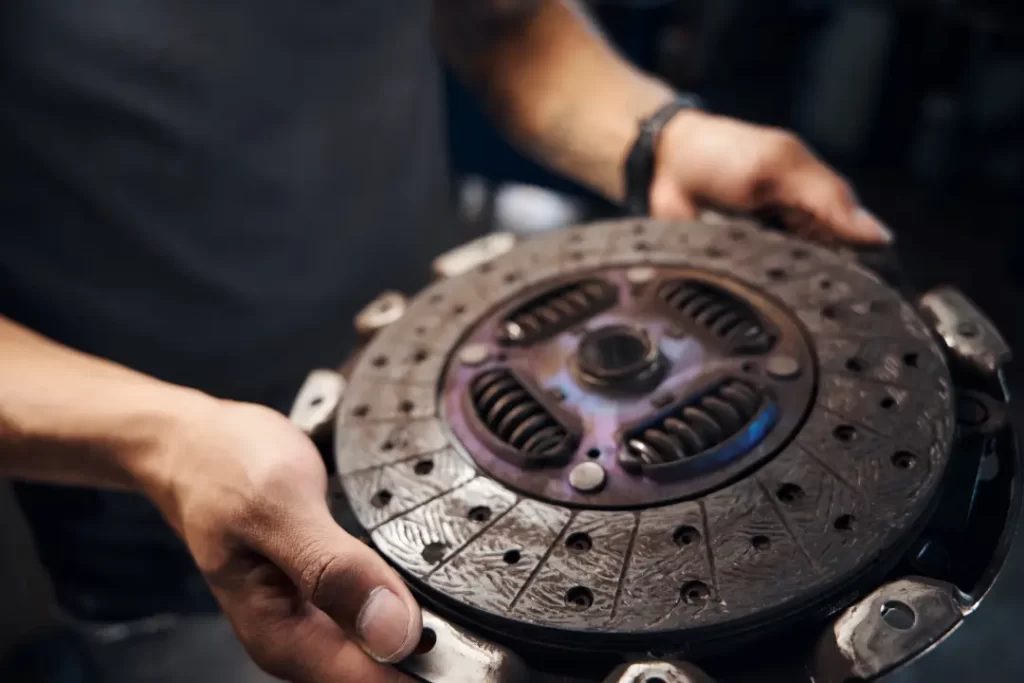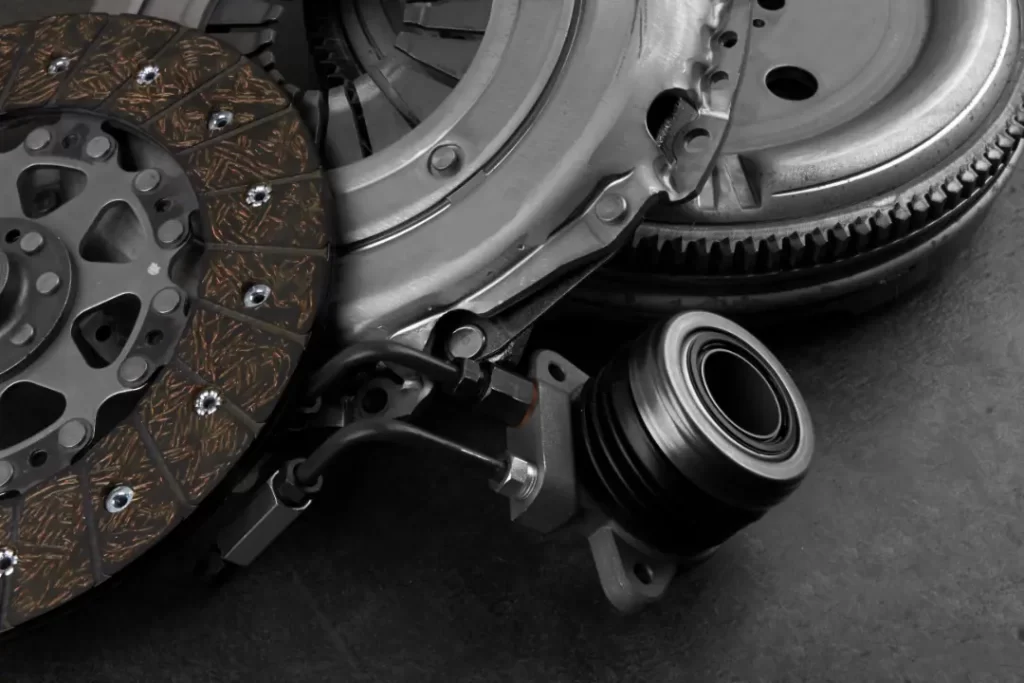Knowing when to replace a clutch helps you maintain consistent performance and a long service life for your manual transmission vehicle. In this guide, we explain the key signs of clutch wear, from gear-shift challenges to unexpected noises. and show how to extend your clutch’s lifespan.
You’ll also learn the essentials of clutch maintenance so you can recognise when it’s time to book a clutch replacement with confidence.
Key Takeaways
- Clutch problems, such as grinding noises, difficulty shifting gears, poor acceleration, and gear slippage, mean it’s time for a professional inspection and possible repair to prevent costly damage.
- A clutch’s lifespan, typically 30,000 to 100,000 miles depending on driving habits and maintenance, can be extended by avoiding riding the clutch and making smooth, timely gear changes.
Understanding the Clutch System
The clutch system in a manual transmission vehicle serves as the critical link between the engine and the wheels. It allows the engine to be separated from the wheels during gear changes and complete stops while the engine is still running.
The clutch is a vital component of the vehicle’s transmission system, as its condition directly impacts performance and safety. The clutch system includes the clutch disc, pressure plate, and flywheel, which work together to transmit power from the engine to the wheels smoothly.
The flywheel and pressure plate play a key role in connecting and disconnecting the engine from the transmission, enabling smooth gear changes and preventing engine stalling. Flywheels, especially dual mass flywheels, help dampen vibrations and improve transmission durability.
A properly functioning clutch is vital for a vehicle to start from a standstill, accelerate, decelerate, and shift gears without damaging the engine or transmission. Clutches are essential for smooth, reliable vehicle operation.

Purpose of the Clutch
The clutch is an essential component of a manual transmission vehicle, designed to manage power flow between the engine and gearbox. Its main purposes within the drivetrain include:
- Engaging and disengaging engine power: Allows the driver to connect or disconnect the engine from the transmission system without switching it off.
- Enabling smooth gear changes: By temporarily separating the flywheel, pressure plate, and clutch disc, it ensures clean, quiet shifting without grinding.
- Controlling vehicle movement: Helps start the car from a standstill and accelerate, decelerate, or stop smoothly.
- Preventing engine stalling: Disconnects power flow during stops or gear transitions to keep the engine running.
- Transmitting torque efficiently: Transfers power from the engine to the wheels, ensuring responsive, predictable vehicle performance.
- Reducing wear on transmission components: Minimises strain on the gearbox and other drivetrain parts, extending system lifespan.
How the Clutch Works
When you press the clutch pedal, the clutch disc, clutch plate, and pressure plate disengage, interrupting the power flow from the engine to the transmission. During this process, the clutch’s internal springs pull the components apart when the pedal is pressed. This disengagement allows you to change gears without damaging the gearbox.
When you release the clutch pedal, the release bearing allows the disc and pressure plate to re-engage, transmitting power from the engine to the wheels again. When the clutch is disengaged, the pressure plate and flywheel spin at different speeds, allowing for smooth gear changes.
This engaging-and-disengaging mechanism enables smooth gear changes and responsive acceleration when driving a manual transmission vehicle. The clutch must engage properly to avoid slipping or difficulty shifting gears.
Types of Clutches
There’s more than one type of clutch, and the one used in your vehicle can depend on factors such as performance characteristics and driving needs. For instance, high-performance vehicles often use a Direct-Shift Gearbox (DSG), a dual-clutch system that combines the efficiency of a manual transmission with the convenience of an automatic.
DSG systems offer quick and fluid gear changes, which are crucial for efficient power delivery in performance vehicles.
How to Identify Clutch Problems
The most noticeable signs of clutch problems can help you identify issues before they become severe. Recognising these warning signs early can prevent further damage and costly repairs.
Here are some signs your clutch may be failing:
- A spongy feel in the clutch pedal
- Clutch judder (vibration when releasing the clutch pedal)
- Unusual noises such as growling, rattling, or squealing
- Grumbling noise when pressing the clutch pedal or changing gear
- Persistent grinding, squeaking, or grumbling noises whenever you press the clutch pedal
- Difficulty shifting gears
- Poor acceleration, even though the engine is revving hard
- Noticeable gear slippage under acceleration
Other signs include a worn-out clutch or clutch plate, which can cause difficulty shifting gears and extra noise.
Ignoring a failing clutch can also damage other transmission components, increasing repair costs and affecting your vehicle’s drivability.
If you notice any of these symptoms, it is essential to have your clutch inspected and repaired as soon as possible.
If your clutch pedal remains stuck to the floor or does not return to its normal position, there is likely a serious fault in the system. This situation signals issues that require immediate attention.
Clutch Slippage
One common clutch problem is a slipping clutch, which occurs when the engine revs but the car doesn’t accelerate. This issue can show as excessive engine revving under acceleration without a matching increase in speed. Worn friction material on the clutch disc often hampers its ability to hold and transmit the engine’s power to the drivetrain, resulting in clutch slippage.
Gear Shifting Issues
Issues with gear shifting can signal problems with the clutch system. If you hear grinding noises when shifting gears, it’s a sign that the clutch is not fully disengaging. If not addressed promptly, this improper disengagement could lead to transmission damage.
Difficulty shifting gears can also indicate gearbox issues related to the clutch system.
Spongy or Loose Clutch Pedal: What It Means and Fixes
A spongy or loose clutch pedal often signals a problem within your car’s hydraulic clutch system, usually involving the master cylinder or slave cylinder. When these components leak or develop air bubbles, you may feel a momentary loss of pressure or a pedal that sinks too easily.
This can also cause incomplete disengagement between the clutch disc and pressure plate, leading to gear-shifting difficulties or slipping.
If your clutch pedal feels unusually soft, check the fluid level and look for leaks near the cylinders or under the gearbox area. A qualified mechanic can perform a quick inspection, bleed the system, and restore normal pedal feel before permanent clutch damage occurs.

What Are the Factors Affecting Clutch Lifespan?
The clutch naturally wears over time with regular use. However, common factors that can affect the lifespan of your clutch include:
- Driving habits
- Traffic conditions
- The type of vehicle you drive
- Your maintenance practices
- The way your vehicle is driven can significantly impact clutch lifespan and overall performance.
A worn clutch can also negatively affect your vehicle’s fuel efficiency by causing slippage and power loss.
The type of vehicle you drive, as well as the specific model, may experience varying rates of clutch wear depending on its design and usage.
The Impact of Driving Habits
Your driving habits can significantly influence the lifespan of your clutch. Aggressive driving with sudden starts and abrupt stops puts extra strain on the clutch, reducing its durability. Similarly, towing heavy loads can stress the clutch, leading to accelerated wear and a shortened lifespan.
Even something as simple as keeping your foot on the clutch pedal when not actively changing gears can cause extra friction and wear.
Maintenance Practices for Your Clutch
Frequent maintenance checks and timely part replacements can significantly extend the service life of your clutch.
Regular vehicle maintenance tasks, such as changing the oil, replacing transmission fluids and filters approximately every 40,000 to 60,000 kilometres, and maintaining proper fluid levels, are essential for clutch longevity. Additionally, routine inspection and adjustment of the clutch cable are important to ensure optimal clutch performance and prevent premature wear.
When to Replace Your Clutch
Knowing when to replace your clutch is crucial for maintaining optimal vehicle performance. The average lifespan of a clutch system is around 60,000 miles, with replacements commonly required after 50,000 to 100,000 miles of driving. However, this can vary based on factors such as driving habits and maintenance practices.
If you notice symptoms of clutch failure, the clutch may need to be replaced to prevent breakdowns. Replacing the clutch at the right time can help avoid further damage and higher repair costs.
It’s important to promptly replace your clutch when it is worn, as there are usually no specific warning lights for clutch issues. Clutch replacement cost can vary significantly depending on your vehicle’s make and model, and early detection of clutch problems can help minimise the overall cost.
Mileage Considerations
The typical lifespan of a clutch in a manual transmission vehicle ranges from 30,000 to 100,000 miles, depending on various factors. Driving conditions and habits significantly influence clutch lifespan, with some drivers needing to replace their clutch well before reaching the 30,000-mile mark. In contrast, others may not require a replacement until surpassing 100,000 miles.
Expert Recommendations
When dealing with clutch problems, it’s always best to seek professional advice. At Ivydene Garage Ltd., we offer expert guidance and professional clutch services for a wide range of vehicle makes and models.
With decades of experience, we are equipped with the latest diagnostic and service equipment, are recognised by Bosch, and can provide you with reliable solutions for your clutch issues.
Tips for Prolonging Clutch Life
Proper usage and maintenance can significantly prolong the lifespan of your clutch system. Here are some tips to help reduce wear and tear on your clutch:
- Avoid habitual riding of the clutch and make smooth, timely gear shifts.
- Shift into neutral when the vehicle is stopped or idle.
- Use the parking brake or handbrake instead of the clutch to hold the car when stationary.
Following these tips can help minimise wear on your clutch and extend its lifespan, potentially reducing the need for clutch repair and unexpected breakdowns.
Avoid Riding the Clutch
One of the most important tips for prolonging clutch life is to avoid riding the clutch. Resting your foot on the clutch pedal, even lightly, can lead to premature wear. Similarly, changing gears before fully depressing the pedal can accelerate clutch wear.
It’s also important to keep your foot off the clutch when accelerating to prevent overheating and premature wear.
Smooth Gear Changes
Smooth gear changes can also help prolong your clutch’s lifespan. Fully disengaging the clutch before changing gears can prevent premature wear of the transmission components. Similarly, shifting gears without fully disengaging the clutch can lead to difficulty in gear selection and potential damage to the gearbox.
Proper fluid levels and hydraulic system integrity are essential for smooth, reliable gear changes with a hydraulic clutch system.
Choose Ivydene Garage for Clutch Replacement in Ashford
When your clutch starts to slip, stick, or make strange noises, it’s time to trust the experts at Ivydene Garage. With over four decades of hands-on experience and a commitment to excellence, our team of highly trained mechanics offers clutch replacement services that are fast, reliable, and competitively priced.
We use only premium-quality parts to ensure the longevity and performance of your vehicle. We understand how disruptive car trouble can be, so we prioritise swift turnaround times without compromising on quality.
Our garage is fully equipped with the latest tools to restore your vehicle and get you safely back on the road with a clutch system you can trust. Book an appointment today.
Bosch Centre of Excellence
Being recognised as a Bosch Centre of Excellence is a testament to our commitment to delivering high-quality automotive solutions. For over four decades, we have been a Bosch agent, equipped to handle the latest automotive technology in vehicles of all makes.
This long-term commitment to excellence underscores our dedication to consistently providing professional and efficient automotive solutions.
Our Comprehensive Services
Our wide suite of automotive services includes:
- MOT tests
- Engine diagnostics
- Car servicing
- Comprehensive clutch replacements
- Tyre and wheel services
- Air conditioning services
We offer a one-stop solution for all your vehicle needs.
Frequently Asked Questions
What is the function of the clutch in a manual transmission vehicle?
The clutch in a manual transmission vehicle allows the engine to be separated from the wheels during gear changes and stops, serving as a critical link between the two.
What are the signs of clutch problems?
If you notice grinding, squeaking, or grumbling noises when pressing the clutch pedal, difficulties in shifting gears, poor acceleration despite a revving engine, or gear slippage, these could be signs of clutch problems. It’s important to have your vehicle inspected for potential issues.
How can I prolong the lifespan of my clutch?
To prolong the lifespan of your clutch, ensure proper usage by avoiding riding the clutch, making timely gear shifts, and maintaining correct fluid levels. Following these steps will help reduce wear and tear on the clutch.
When should I replace my clutch?
You should consider replacing your clutch system after 50,000 to 100,000 miles of driving, although your driving habits and maintenance routines can influence the specific lifespan.
What services does Ivydene Garage Ltd. offer?
Ivydene Garage Ltd. offers a full suite of automotive services, including MOT tests, engine diagnostics, car servicing, clutch replacements, tyre and wheel services, and air conditioning services.
Ready to Take the Next Step?
Understanding the clutch system, recognising the signs of clutch problems, and knowing when to replace your clutch are crucial for maintaining your vehicle’s performance and longevity.
Regular maintenance, good driving habits, and timely clutch replacements can significantly prolong your clutch’s lifespan and prevent costly repairs.
At Ivydene Garage Ltd., we are committed to providing expert clutch services and comprehensive automotive solutions to meet your vehicle’s needs.
